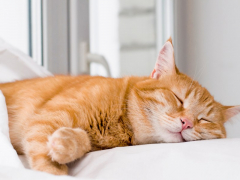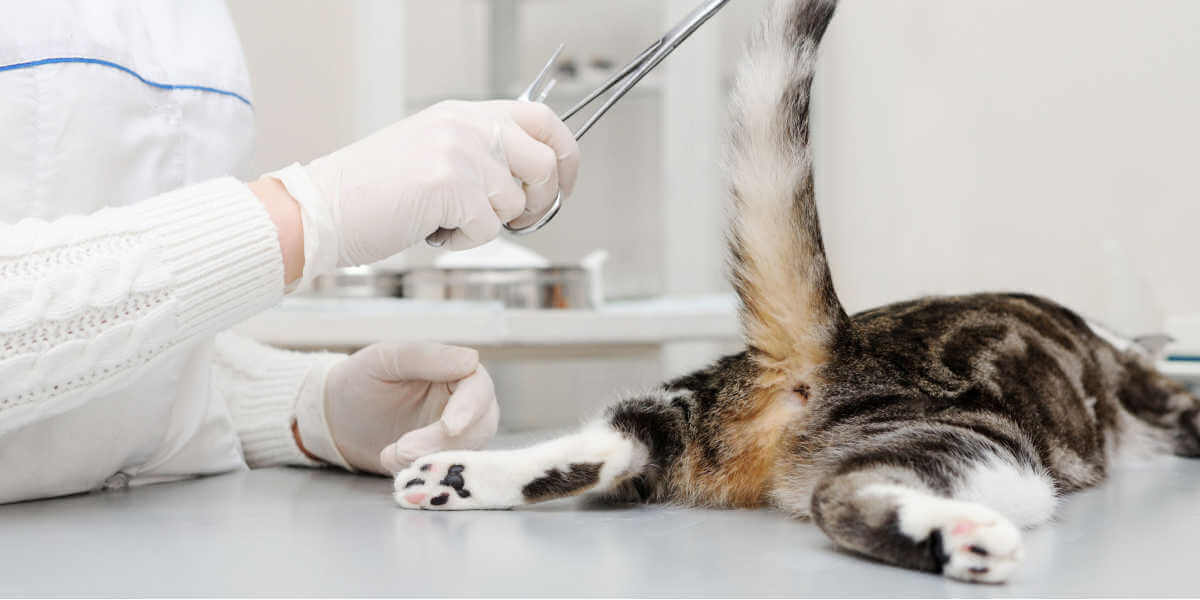
The aim of this article is to provide a simple, clear explanation about bleeding from the anus for cat owners whose pets may be affected, and who want to understand more about what’s happening.
Quick Overview: Cat Bleeding From the Anus







Also Read: What To Do If You See Blood In Your Cat’s Stool?
Feline Rectal Bleeding
Bleeding from the anus means that fresh blood is being passed from the cat’s butt. The anus is the termination of the digestive tract, from which feces is passed. The technical veterinary term for this is “hematochezia”, a word derived from the Greek for “blood” (haemato) and the Greek for “to defaecate” (chezia).
Also Read: Blood In Cat Urine (Hematuria): Causes, Symptoms, & Treatment
What Causes Bleeding From the Anus
Hematochezia can be caused by a long list of possible causes. The main issue is that something is causing bleeding into the lower bowel, and this blood then passes out via the anus, either as part of the cat’s stool or as separate bleeding. Possible causes of blood being seen at the anus include:
- Food allergies causing inflammatory bowel disease (IBD) which can affect any part of the digestive tract including the stomach, the small intestines and the lower bowel (causing colitis)
- Ingestion of any irritant substance (e.g. toxins or poisons) that causes inflammation of the bowel
- Side effects of medication
- Viral infections
- Bacterial infections
- Intestinal parasites e.g. roundworms, hookworms or tapeworms
- Protozoal infections such as Giardia
- Physical irritants such as trauma e.g. bite wounds close to the anus, ingested foreign objects (such as bones or needles) causing direct damage to the anus or lower intestinal tract (rectum or colon), or any other cause of physical disruption of the lining of the anus and nearby areas.
- Other diseases of the gastrointestinal tract e.g. tumors or rectal polyps, rectal prolapse.
- Diseases of the anal glands, including anal sac abscesses, can cause bleeding into the anal sacs which then is seen at the anus or in the poo
How Common Is Bleeding From the Anus?
Bleeding from the anus is fairly uncommon in cats.
Symptoms of Bleeding From the Anus in Cats
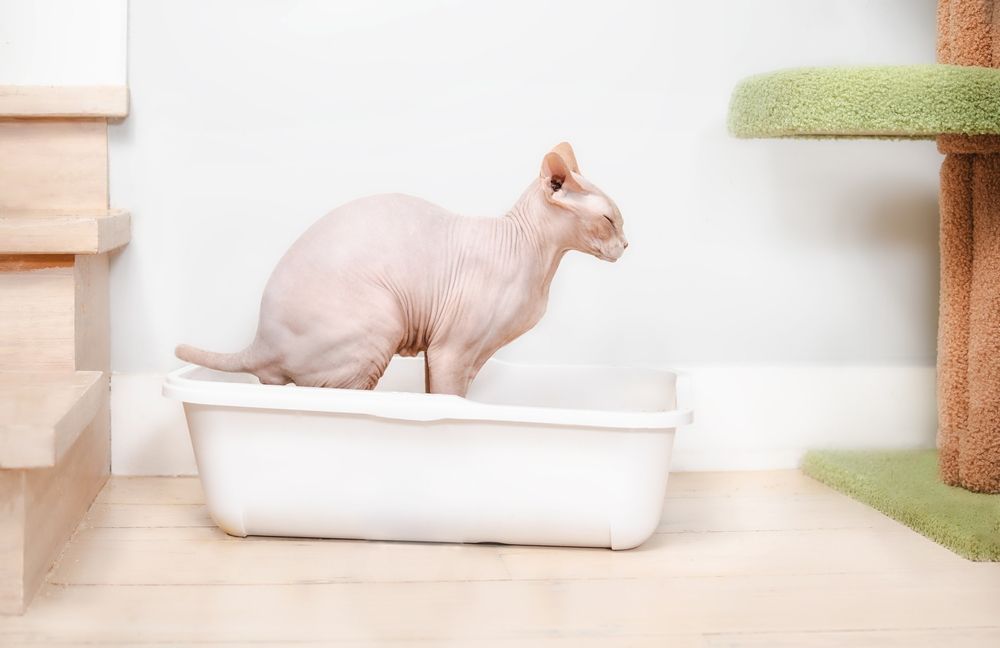
Cat owners should keep a close eye on their cat’s toileting habits, as changes to feces and urination can be signs of disease.
The main sign of bleeding from the anus is exactly what it says: fresh or digested blood being noticed coming from the anus. This may be seen in the litter tray (on or around the poop), or it may be noticed as blood on the skin when the tail is lifted and the area inspected.
When bleeding from the anus is noticed, the following signs may also be seen:
- Diarrhea, or jelly-like mucus, being passed
- Tenesmus (straining to pass feces)
- Increased urgency or frequency of passing feces
- Accidents e.g. outside the litter box, or inside the cat flap (caught short on the way to going outside to carry out defecation)
- Increased flatulence may be noted in some cases
- Other signs of illness such as lethargy, dullness, weakness or weight loss may be noticed
Also Read: 10 Most Dangerous Diseases In Cats
Diagnosis of Bleeding From the Anus
If your cat has bleeding from the anus, you should take them urgently to your DVM veterinarian where the following steps may be taken.
1. Detailed History Taking
Your vet will discuss every aspect of your cat’s condition and overall health care, looking for clues about why your pet is unwell, and in particular finding out about anything that might affect the digestive system.
This will include asking about your pet’s vaccination status, appetite, dietary history (including any supplements given), parasite control program, contact with other cats, and toileting habits. Are there any other signs of digestive upset, such as vomiting? They will ask about your cat’s behavior in detail: have you noticed painful defecation? What the cat feces look like? Is it normally formed or is there diarrhoea?
Is it a small amount of blood, or does it make up most of the fecal material? Is it pure blood, or is there pus as well?
It may be helpful for you to take photographs of your cat’s poop, as well as bringing a sample with you to the vet.
One important question is: what type of blood has been seen at the anus?
- Fresh blood (bright red blood) indicates that the bleeding is happening in the lower intestinal tract (colon or rectum), close to the anus
- Darker colored blood (e.g. coffee grounds or black tar appearance) indicates digested blood, suggesting that the bleeding started higher in the digestive tract e.g. small intestines.
2. Physical Examination
Your veterinarian will check your cat over carefully all over. This will include an inspection of the mouth and teeth, careful palpation of the abdomen, listening to the chest and abdomen with the stethoscope, and a careful inspection of the cat’s anus and surrounding area.
Occasionally, the nature of the trace of feces on the thermometer may be inspected after the temperature has been taken (if your cat has bleeding from the anus, feces, mucus or jelly may be seen as well as blood). The color of the gums will be checked: pale gums can suggest excessive blood loss, or even the possibility of internal bleeding as well as the blood that has been seen at the anus.
3. Routine Blood Tests, Urinalysis and Fecal Analysis
After the physical examination, it’s very likely that your veterinarian may carry out a range of further investigations to try to pinpoint the cause of the bleeding from the anus. This will often start with blood work, including the usual panel of diagnostic tests, such as hematology (complete blood count with assessment of red and white blood cells) and biochemistry profiles.
These tests will check that your cat is fundamentally healthy, and not suffering from internal issues such as liver disease or kidney disease. Blood tests are also useful to assess your cat’s level of hydration, as dehydration is common when cats are passing blood from the anus. The tests will also check to see if your cat has developed anemia, which is common when an animal is losing blood.
Urinalysis will be carried out as with many other sick cats, as part of a general investigation. Fecal analysis may include standard fecal flotation and examination, and stained cytology for parasites and bacteria, as well as checking for abnormal blood cells. PCR analysis of feces may be used to check for specific pathogens that may cause signs that include bleeding from the anus.
4. Specialized Blood Tests
Some specific tests may be carried out, such as folate and Vitamin B12 (cobalamin) as these can be altered in some cases of inflammatory bowel disease (IBD) which can lead to bleeding from the anus. The thyroid hormone level may also be assessed, especially if your cat is older
Your veterinarian may recommend specific blood tests for some viral infections such as Feline Leukemia Virus (FeLV) and Feline Immunodeficiency Virus (FIV), since these can be linked to the underlying cause of bleeding from the anus and there are significant implications if your cat is positive for either of these.
5. Other Tests
- Radiographs (x-rays) may be taken of the abdomen to check for other causes of the signs shown by your cat (including screening for foreign items or blockages in the digestive tract), as well as checking to see if there is any unusual build up of fecal material in the colon with constipation.
- Ultrasound can be a useful way of assessing the structure of abdominal organs, making sure that everything appears normal. This can also be used to evaluate aspects of the lower bowel, such as the thickness of the wall of the colon and the presence of unexpected growths.
- Blood pressure measurement may be carried out to assess your cat’s general health.
- Endoscopy may be carried out to view the internal structure of the mucosal lining of your cat’s colon. This is helpful to check for physical damage such as a tear in the lining of the rectum, as well as looking for strictures, lumps, etc. In some cases, endoscopy may be used to take a biopsy to make a definitive diagnosis of the cause of bleeding from the anus e.g. if a growth is identified in the lower bowel area.
Your veterinarian will advise you on which detailed investigations are needed.
Also Read: Top 10 Things Your Vet Wishes You Knew
Treatment
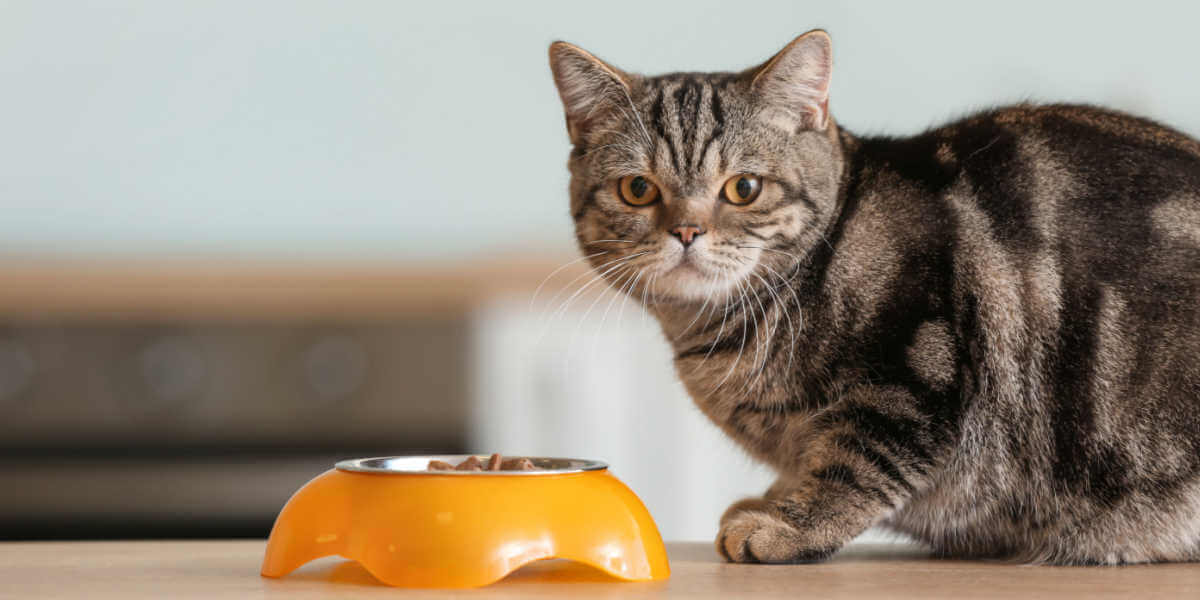
Cats with blood from their anus may need a specialized diet.
Generalized Treatments
Mild cases of bleeding from the anus may be given a general, “cure all” treatment for GI tract irritation without full investigations as listed above, and this treatment may include:
- A bland, easily digestible diet (such as a proprietary “gastrointestinal diet”) for 24 to 48 hours may be an initial first aid treatment if there is just a trace of blood and the cat is completely normal in every other way.
- General treatment for parasites that could cause bleeding from the lower bowel may be given, using worming medications such as fenbendazole or pyrantel.
- Probiotics may be given to reseed the lower bowel with healthy bacteria, as bacterial populations of the digestive tract are thought to make a significant contribution to the digestive processes.
- Occasionally, an antibiotic trial may be undertaken using a product such as metronidazole which has anti-inflammatory as well as antibiotic properties. However in these days of cautious antibiotic stewardship, it’s more likely that dietary therapy and probiotics will be recommended before resorting to antibiotics
- A specialized diet may be considered to rule out dietary allergies and intolerances that may have provoked a strong inflammatory reaction that could include bleeding of the lower bowel.
Types of specialized diet
Beef, wheat and corn are the most common allergy-inducing proteins. Suitable diets are either “novel protein” diets i.e. containing proteins that the cat is unlikely to have encountered before (such as certain fish species or unusual meat, like venison).
The second option is hydrolyzed diets which are created using one protein source (such as soy, rice, or potato) which has been digested (hydrolyzed) in the factory to create low-molecular-weight short-chain protein derivatives that are both highly digestible as well as having very low antigenic challenge.
Alternatively, some cats with severe inflammatory bowel disease leading to bleeding from the anus respond to diets containing highly fermentable fiber such fructoligosaccharides (these are also known as prebiotic diets) which promote “good” bacteria while inhibiting some “bad” bacteria. Soluble fiber such as psyllium can also be added to regular diets as a separate supplement to help with fecal consistency.
Specific Treatments
If a cat with bleeding from the anus does not respond to this general treatment, then the full, detailed investigation may need to be carried out, including a biopsy to make a specific diagnosis of the cause of the bleeding from the anus.
The biopsies may show, for example, specific inflammatory cells in the wall of the lower bowel with possible changes including diagnoses such as lymphocytic-plasmacytic, eosinophilic, neutrophilic, or granulomatous enteritis.
Specific treatment may then be given for the underlying cause if this can be identified.
Typically, for bleeding from the anus caused by inflammatory bowel disease (i.e. when inflammatory cells are identified in inflamed areas of the lower bowel), anti-inflammatory or immunosuppressive medication may be given, such as corticosteroids or stronger immunosuppressive drugs.
Anal sac disease needs to be treated specifically, depending on precisely what is going on e.g. flushing and/or antibiotics for infected anal sacs.
If there is an issue such as narrowing of the lower bowel due to strictures, balloon dilation way be used to widen the area.
Other diseases e.g. tumors (such as lymphoma) may also be diagnosed by biopsy, and these may require surgery, chemotherapy or other approaches.
Home Remedies
A bland, easily digestible diet (such as a proprietary “gastrointestinal diet”) for 24 to 48 hours may be an initial first aid treatment if there is just a trace of blood and the cat is completely normal in every other way.
Also Read: Cat Anal Gland Problems: Causes, Symptoms & Treatment
Monitoring and Prognosis
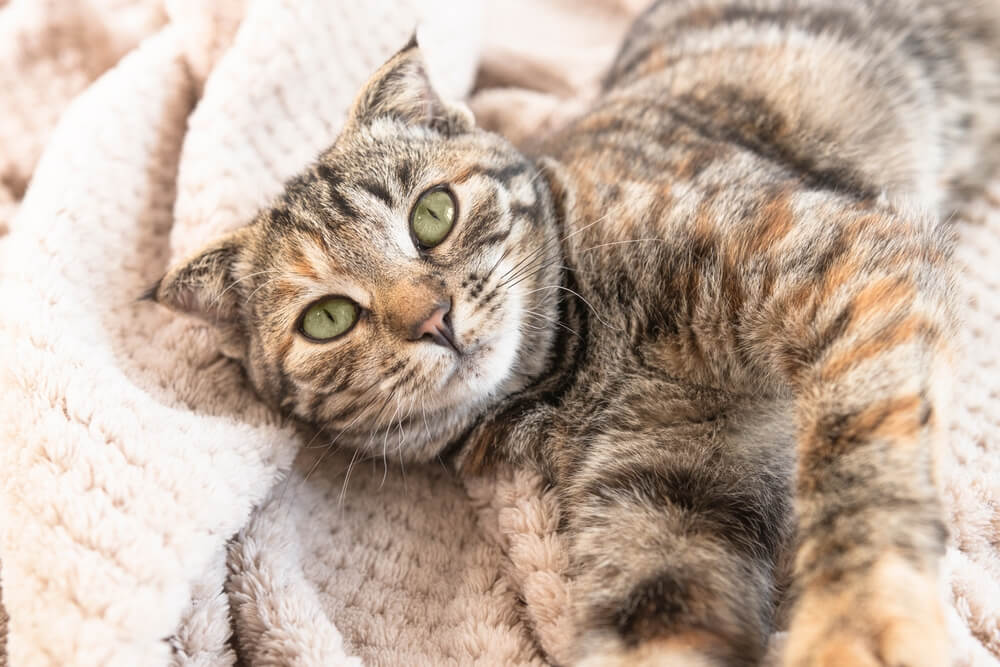
Many causes of bleeding from the anus are transient, and can be managed and relieved.
Your veterinarian will advise you on what follow up care is needed, but in general, monitoring your pet for further signs of bleeding from the anus is the main way to confirm that a full recovery is underway.
The prognosis for most cases of bleeding from the anus is very good, although if a tumor is present, this may not be the case.
Conclusion
Bleeding from the anus is a common complication of a number of lower bowel diseases in cats. In very minor cases, a simple treatment may suffice, but if the problem continues or if the cat seems otherwise unwell, urgent veterinary intervention is important.
Also Read: Cat Constipation: Causes, Treatment, & Remedies
Frequently Asked Questions
How long does bleeding from the anus last in a cat?
A minor bout of a trace of bleeding from the anus (e.g. a reaction to a particular food) may only last 24 - 48 hours. If the signs of bleeding from the anus are more significant or go on for longer than this, it's important to discuss more focused treatment and perhaps a more detailed investigation with your veterinarian.
How do you treat bleeding from the anus in cats?
A simple case of minor bleeding from the anus may be treated by offering a bland, highly digestible food for 24 to 48 hours as long as the cat is bright, behaving normally and eating. If a cat continues to show signs of bleeding from the anus, if they become dull, or if they stop eating, urgent veterinary intervention is essential to identify the underlying cause.




